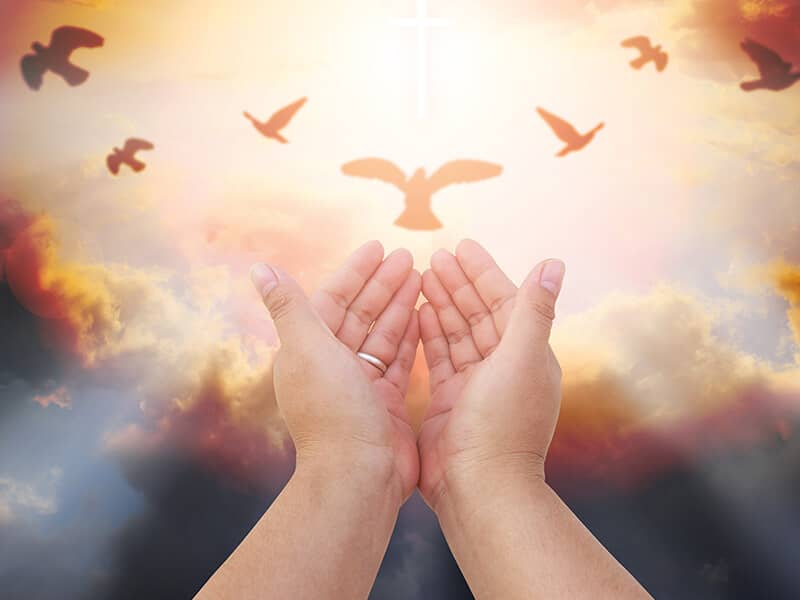Here in El Pueblo de Nuestra Señora la Reina de los Angeles, "The City of Our Lady, Queen of the Angels," a city most people know as Los Angeles, one cannot go long without encountering Our Lady of Guadalupe. She gazes tranquilly from the stucco walls of convenience stores, from the black dashboards of cars, from gold medallions, from the blue ink of tattoos.
Her story and my people's traditions surrounding la Virgen remain powerful because she speaks to the deepest recesses of the human soul. For more than four hundred years before the Second Vatican Council's "Pastoral Constitution on the Church in the Modern World" (1965), she was teaching an entire people every day how to share the joy and hope, the grief and anxiety of the whole human race.
There was snow on the ground that December morning of 1531 when a poor fifty-seven-year-old Aztec widower named Juan Diego Cuauhtlatzin approached Tepeyac Hill on his fifteen-mile walk to Mass. He climbed the hill because he heard music and someone softly calling his name: ¡Juanito! ¡Juan Dieguito! It was an affectionate form of his name, as though she were calling, "Johnny! Little John Diego!" There he encountered a young Indian woman, dark like him, wearing traditional Aztec garb, including the black sash around her waist indicating she was pregnant.
She told him she was Mary and that she desired a church to be built there, where she could hear her people's weeping and sorrows and console them. He was to inform the bishop of Mexico City of her request. Bishop Zumárraga was a proud Spaniard, and he shooed away this ignorant Indian. Juan Diego reported the bishop's dismissal to the lady. She sent him back. The bishop again sent him away disdainfully, this time demanding a miracle.
His Excellency got his miracle and then some. When Juan Diego arrived at the bishop's palace the third time, he dumped out roses the lady had picked from Tepeyac's snowy rocks and arranged in his rough cloak, his tilma. There on his cloak was the image of the very lady he had met on the hill, an image preserved to this day in the basilica dedicated to her outside Mexico City.
On Tepeyac Mary did not threaten calamity, or tell the pope to say a certain prayer on a particular day, or confirm a fine point of Augustinian theology. She promised only to listen to anyone who would come to her. She offered only companionship, compassion, and consolation. But this simple gift has resonated through the world for hundreds of years, an earthy song of divine pathos sung by millions of voices that only grows stronger with time.
The third gift of Tepeyac deals with issues of authority. In the story, the bishop is the obstacle, and the conquered peasant carries the world-changing message. This is why, in my world, when her oppressed children cry out-whether janitors massing at city hall, or farm workers protesting along a dusty road in California's Central Valley, or gay and lesbian Catholics marching down Santa Monica Boulevard, anawim of every stripe-they always carry an image of Our Lady of Guadalupe. We know she walks with us. Impoverished, immigrant, indigenous, or "intrinsically disordered," we remember her words of assurance to Juan Diego: ¿No soy tu madre? ("Am I not your mother?") Yes, we remember. We remember with a memory of centuries that can only be described as pondering these things in our hearts.
If I wish to clothe myself in the reality of the Magnificat, I cut my own life's pattern tracing the story of Tepeyac. If I am denied a job because of who I am, if I am denounced in the halls of Congress as a godless outsider, derided as a pragmatically deprived idealist, as a troublemaker, as someone who asks the question everyone else is afraid to ask, as someone whose refusal to play by the rules makes others think I just don't get it, or just as someone scorned on the street, then the story of Tepeyac comes alive in me. The story reminds me that my Father and my Mother accept and love me for all the reasons that move others to despise me. When powers are arrayed against me, when the proud look down from their thrones, I am Juan Diego; I open my tilma and flowers cascade from it. I revel in my weakness. And I am lifted up.
On Tepeyac stands a lady who shelters the oppressed, the marginalized, those who are less-than. She trusts me to carry a message without having a fancy title. She hears me in my despair and comforts me. But she also teaches me the power of love, love despite all tribulation, a screaming, starving love fed only with hope.

